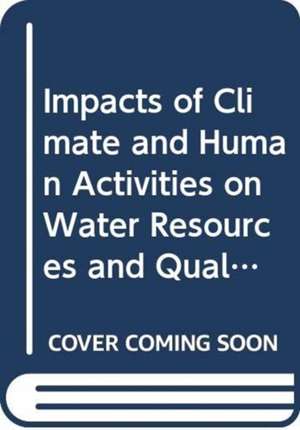Impacts of Climate and Human Activities on Water Resources and Quality: Integrated Regional Assessment
Autor Weili Duan, Kaoru Takaraen Limba Engleză Hardback – 30 mar 2020
| Toate formatele și edițiile | Preț | Express |
|---|---|---|
| Paperback (1) | 885.49 lei 6-8 săpt. | |
| Springer Nature Singapore – 25 aug 2021 | 885.49 lei 6-8 săpt. | |
| Hardback (1) | 891.48 lei 6-8 săpt. | |
| Springer Nature Singapore – 30 mar 2020 | 891.48 lei 6-8 săpt. |
Preț: 891.48 lei
Preț vechi: 1087.17 lei
-18% Nou
Puncte Express: 1337
Preț estimativ în valută:
170.59€ • 182.41$ • 142.23£
170.59€ • 182.41$ • 142.23£
Carte tipărită la comandă
Livrare economică 18 aprilie-02 mai
Preluare comenzi: 021 569.72.76
Specificații
ISBN-13: 9789811393938
ISBN-10: 9811393931
Pagini: 218
Ilustrații: XIV, 183 p. 103 illus., 102 illus. in color.
Dimensiuni: 155 x 235 mm
Greutate: 0.46 kg
Ediția:1st ed. 2020
Editura: Springer Nature Singapore
Colecția Springer
Locul publicării:Singapore, Singapore
ISBN-10: 9811393931
Pagini: 218
Ilustrații: XIV, 183 p. 103 illus., 102 illus. in color.
Dimensiuni: 155 x 235 mm
Greutate: 0.46 kg
Ediția:1st ed. 2020
Editura: Springer Nature Singapore
Colecția Springer
Locul publicării:Singapore, Singapore
Cuprins
Introduction.- Extreme Precipitation Events, Floods and Associated Socio-economic Damages in China in Recent Decades.- Changes of Water Quality in the Yangtze River Basin.- Spatiotemporal Evaluation of Water Quality and Water Quality Incidents over Japan.- Assessment of Precipitation Amounts and Climate Extremes in Japan.- Precipitation Changes in Hokkaido and Future Water Resources in Its Main Rivers.- Estimation of Nutrient and Suspended Sediment Loads in the Ishikari River.- The Aral Sea Basin Crisis and Future Water- Climate- Food Nexus in Turkmenistan.
Notă biografică
Weili Duan is a Professor in water resources and climate change at the State Key Laboratory of Desert and Oasis Ecology, Xinjiang Institute of Ecology and Geography, Chinese Academy of Sciences. Weili pursued a PhD degree at the Department of Civil and Earth Resources Engineering, Kyoto University, Japan. His research interests are water for sustainable development, climate change and water-related disasters management.
Kaoru Takara is the dean and professor at the Graduate School of Advanced Integrated Studies in Human Survivability, Kyoto University. He has been contributing to international cooperation research activities through UNESCO International Hydrological Programme (IHP), Asia Pacific Association of Hydrology and Water Resources (APHW), International Association of Hydrological Sciences (IAHS), International Water Resources Association (IWRA), International Consortium on Landslides (ICL), and so on. His research focuses specifically on physically-based stochastic hydrological analysis.
Kaoru Takara is the dean and professor at the Graduate School of Advanced Integrated Studies in Human Survivability, Kyoto University. He has been contributing to international cooperation research activities through UNESCO International Hydrological Programme (IHP), Asia Pacific Association of Hydrology and Water Resources (APHW), International Association of Hydrological Sciences (IAHS), International Water Resources Association (IWRA), International Consortium on Landslides (ICL), and so on. His research focuses specifically on physically-based stochastic hydrological analysis.
Textul de pe ultima copertă
With the rapid increase of world population, the global water shortage is set to be the major crises of the twenty-first century; that is, population dynamics (growth, age distribution, urbanization and migration) create pressures on freshwater resources due to the increased water demands and pollution. Moreover, water resources management faces a new uncertainty- i.e. the potential for longer-term and more persistent climate change nowadays, which, in coming years, may significantly affect the availability of supply and patterns of water demand. This book mainly focuses on the impact of climate change and human activities on water quality and water resources in Asia Countries. It begins by describing the characteristics of water related disasters in the world. Then, the book analyzes the changes of floods and associated socio-economic damages for whole China over the last century, and assesses water quality and pollution source for the Yangtze River Basin, suggesting water-related disasters would become more intense, longer lasting, and/or more frequent in a future warmer climate. Then, after investigating spatiotemporal trends and causes of water quality and water quality incidents (Chapter 4) and precipitation extreme events (Chapter 5) in Japan, subsequent two chapters mainly evaluate the climate and human impacts on precipitation variations, water quality and water resources in the Hokkaido area. The final chapter comprehensively analyzes climate change impacts on water resources in the Aral Sea Basin, and then estimate the water requirements and water deficits for irrigation, future agricultural yields of seven major crops, and land and water productivity in four provinces of Turkmenistan considering climate change, population growth, and three socio-economic development scenarios. All results obtained from this book may provide a means to reduce water quality incidents and mitigate future negative impacts by adapting water management. Furthermore, the improved methods for water quality modeling in data scarce regions are transferable to other study areas and applicable in future research.
Caracteristici
1) Presents a spatiotemporal evaluation of the changes of extreme precipitation events, floods and associated socio-economic damage in China over the last century.
2) Provides new ways to realize and reduce water quality incidents
3) Explores precipitation extremes changes and its possible correlation with climate indices in over 100 years.
4) Shares mitigation of water incidents by adapting water management
5) Demonstrates how to improve water quality modeling in data scarce regions and set good examples that are transferable to other study areas
6) Provide tools to assist resource managers to identify vulnerabilities in the nexus of water, land and climate to ensure food security, water management, and sustainable development.
2) Provides new ways to realize and reduce water quality incidents
3) Explores precipitation extremes changes and its possible correlation with climate indices in over 100 years.
4) Shares mitigation of water incidents by adapting water management
5) Demonstrates how to improve water quality modeling in data scarce regions and set good examples that are transferable to other study areas
6) Provide tools to assist resource managers to identify vulnerabilities in the nexus of water, land and climate to ensure food security, water management, and sustainable development.
